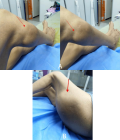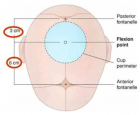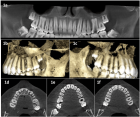Early Online (Volume - 9 | Issue - 1)
Clinical Severity of Sickle Cell Anaemia in Children in the Gambia: A Cross-Sectional Study
Published on: 8th January, 2025
Background: Sickle cell anaemia (SCA) in children demonstrates a broad range of clinical manifestations and serious complications. Assessment of disease severity in specific populations is necessary to plan services and optimise care. Aim: To describe the clinical severity of SCA and associated sociodemographic and clinical factors in children in Gambia.Methods: The presence of lifetime complications was confirmed by history and review of medical charts. We determined clinical severity using a validated scoring system and related the severity to sociodemographic and clinical factors.Results: In 130 study participants, ages ranged from 5 to 15 years with a mean (SD) age of 9.74 (2.81) years. Eleven (8.5%) children had had acute chest syndrome, 7 (5.4%) avascular necrosis of the femoral head, 6 (4.6%) gallstones, 5 (3.8%) stroke and 1 (0.8%) priapism over their lifetime. Disease severity was classified as mild in 108 (83.1%) children, moderate in 17 (13.1%) and severe in 5 (3.8%). Age, age at diagnosis, sex, ethnicity, social class, and treatment with hydroxyurea was not significantly correlated with SCA clinical severity (P values 0.10-0.84).Conclusion: The high proportion of children with mild disease may be due to the high prevalence of Senegalese β-haemoglobin haplotype in the Senegambia subregion. However, the presence of moderate or severe disease in almost 1 in 5 children calls for concerted efforts in SCD care in this region.
Effects of the Snuff with Sodium Bicarbonate (Toumbak) on the Blood Pressure among Sudanese Users
Published on: 29th July, 2025
Background: Toumbak, a form of smokeless tobacco made from Nicotiana rustica and sodium bicarbonate, is widely used in Sudan and poses potential health risks, particularly concerning cardiovascular function. Despite its high prevalence, especially among adult males, limited data exist regarding its impact on blood pressure.Objective: To assess and compare blood pressure parameters among Sudanese Toumbak users and non-users, and to investigate the association between Toumbak use, age, and gender with systolic blood pressure (SBP), diastolic blood pressure (DBP), and pulse pressure (PP).Methods: A comparative cross-sectional study was conducted from 2022 to 2025 among 1000 Sudanese adults (500 Toumbak users and 500 matched non-users) aged 18–60 years in Khartoum State. Blood pressure measurements were recorded using a digital sphygmomanometer following WHO guidelines. Independent t-tests and ANOVA were used to compare SBP, DBP, and PP between groups. A p - value < 0.05 was considered statistically significant.Results: Toumbak users exhibited significantly elevated SBP (141.7 ± 21.9 mmHg), DBP (89.3 ± 6.0 mmHg), and PP (52.4 ± 19.3 mmHg) compared to non-users (SBP: 121.2 ± 3.2 mmHg, DBP: 80.5 ± 3.8 mmHg, PP: 40.7 ± 3.9 mmHg), with p < 0.001 for all parameters. Males demonstrated significantly higher SBP (145.6 ± 24.0 mmHg) and PP (56.7 ± 22.1 mmHg) than females (SBP: 137.8 ± 18.6 mmHg, PP: 48.2 ± 14.5 mmHg). While no statistically significant differences were observed in BP across age groups, adolescents and middle-aged users had the highest SBP.Conclusion: Toumbak use is significantly associated with elevated blood pressure and increased cardiovascular risk, particularly among male users. These findings highlight the need for targeted public health interventions and awareness campaigns addressing the health consequences of smokeless tobacco in Sudan.
CRISPR9 SCD Gene Therapy
Published on: 22nd August, 2025
The most prevalent monogenic blood illness is sickle cell disease (SCD), which affects millions of people globally and around 100,000 Americans.
Rare Locations of Plasma Cell Tumour: A Single-Centre Experience
Published on: 27th August, 2025
Extramedullary involvement, also known as Extramedullary Disease (EMD), represents a highly aggressive variant of plasma cell dyscrasias. It is characterised by the presence of plasma cell clones that proliferate independently of the bone marrow microenvironment. While EMD most commonly affects the skin and soft tissues, in cases of disease relapse, it may extend to internal organs, including the liver, kidneys, central nervous system, chest wall, pleura, and pericardium.The reported incidence of EMD varies. A comprehensive review of the literature indicates that in newly diagnosed Multiple Myeloma (MM) patients, the incidence ranges from 0.5% to 4.5%. However, in relapsed or refractory MM, the incidence increases markedly, reaching between 3.4% and 14%. Prognosis remains poor, particularly when the paravertebral region is involved, as this often leads to vertebral body fractures that complicate treatment and worsen outcomes.Current data on therapeutic responses are primarily based on retrospective studies. Therefore, prospective trials are needed to more accurately assess the efficacy of various treatment regimens. This study presents a cohort of patients with paravertebral plasma cell tumours, with a specific focus on tumour location, associated vertebral fractures, available treatment strategies, and clinical responses following induction therapy.
Clinical Performance of the Erba H7100 Hematology Analyzer: Focus on Reticulocytes
Published on: 18th September, 2025
This study comparatively evaluated the analytical performance of the Erba H7100 hematology analyzer against the Siemens Advia 2120i and Beckman Coulter DXH 900, using 243 patient samples. The study assessed the agreement and linear relationship across 14 key hematological parameters in whole blood, employing statistical methods that included mean bias, standard deviation of the difference, Pearson’s correlation, and coefficient of determination. Additionally, reticulocyte counts were analyzed in 27 samples for Erba H7100 vs. Advia 2120i and 53 samples for Erba H7100 vs. DXH 900, revealing exceptional agreement with high Pearson’s r and r-squared values. The performance of the Erba H7100 and DXH 900 in analyzing ascitic, cerebrospinal, and bronchial wash fluids was also evaluated. Notably, the Advia 2120i analyzer exhibited discrepancies in mean corpuscular volume (MCV) and monocyte counts (Mon#). Conversely, the Erba H7100 showed better agreement with the DXH 900 for MCV and Mon# in whole blood. In fluid samples, Erba H7100 and DXH 900 demonstrated a strong correlation with Microscopy in determining Neutrophil % and Lymphocyte % values. Strong linear correlations were observed for most parameters in whole blood, with reticulocyte counts showing near-perfect correlation. This study underscores the importance of rigorous validation and potential platform-specific reference intervals to ensure accurate and reliable hematological testing, emphasizing the need for standardized methodologies in clinical laboratories.
Clinical Performance of the Erba H7100 Hematology Analyzer: Focus on Reticulocytes
Published on: 18th September, 2025
This study comparatively evaluated the analytical performance of the Erba H7100 hematology analyzer against the Siemens Advia 2120i and Beckman Coulter DXH 900, using 243 patient samples. The study assessed the agreement and linear relationship across 14 key hematological parameters in whole blood, employing statistical methods that included mean bias, standard deviation of the difference, Pearson’s correlation, and coefficient of determination. Additionally, reticulocyte counts were analyzed in 27 samples for Erba H7100 vs. Advia 2120i and 53 samples for Erba H7100 vs. DXH 900, revealing exceptional agreement with high Pearson’s r and r-squared values. The performance of the Erba H7100 and DXH 900 in analyzing ascitic, cerebrospinal, and bronchial wash fluids was also evaluated. Notably, the Advia 2120i analyzer exhibited discrepancies in mean corpuscular volume (MCV) and monocyte counts (Mon#). Conversely, the Erba H7100 showed better agreement with the DXH 900 for MCV and Mon# in whole blood. In fluid samples, Erba H7100 and DXH 900 demonstrated a strong correlation with Microscopy in determining Neutrophil % and Lymphocyte % values. Strong linear correlations were observed for most parameters in whole blood, with reticulocyte counts showing near-perfect correlation. This study underscores the importance of rigorous validation and potential platform-specific reference intervals to ensure accurate and reliable hematological testing, emphasizing the need for standardized methodologies in clinical laboratories.

If you are already a member of our network and need to keep track of any developments regarding a question you have already submitted, click "take me to my Query."

















































































































































